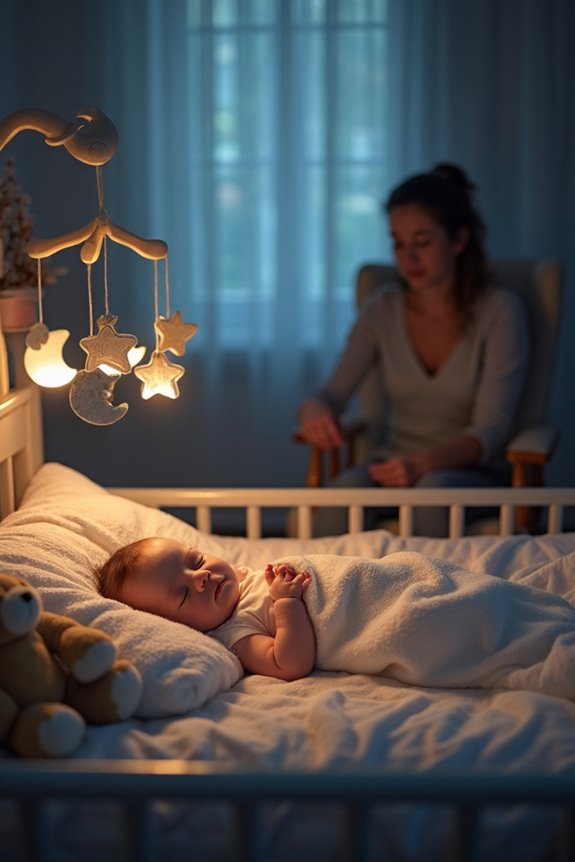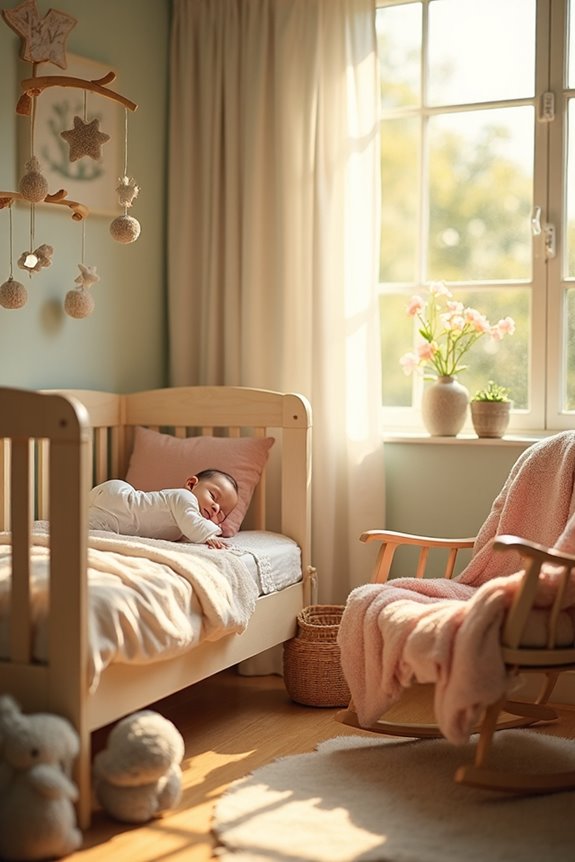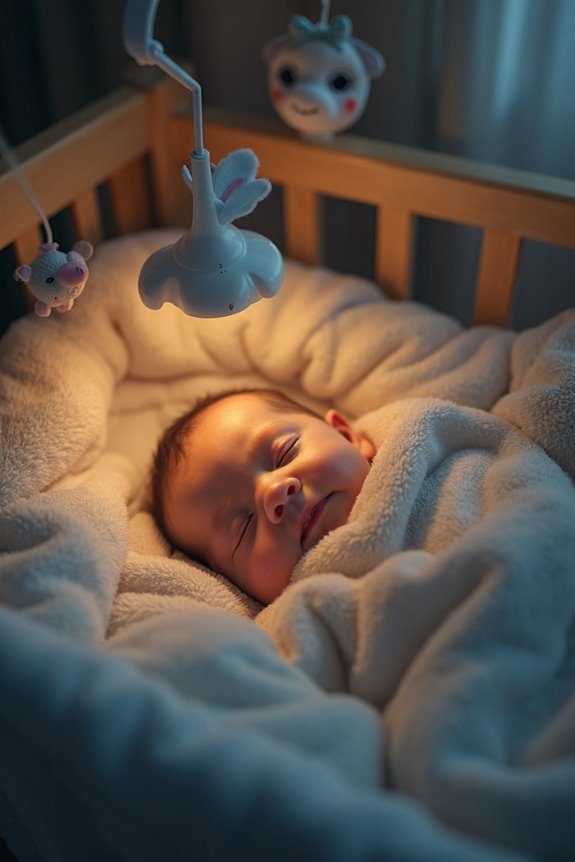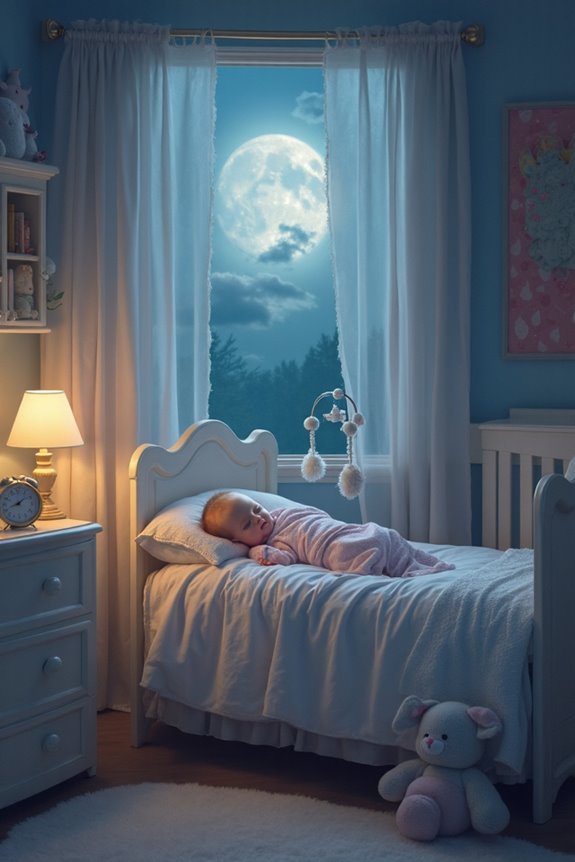We often wonder if babies experience nightmares, especially given how much REM sleep they get. While their rapid eye movements and brain activity during this stage resemble ours, infants likely don’t deal with nightmares as adults do. Their cognitive abilities aren’t fully developed yet, and distress might stem from physical discomfort or hunger. Understanding infant sleep patterns, like avoiding overtiredness with a consistent bedtime, is critical. For insights into supporting their sleep, let’s explore further.
Key Takeaways
- Infants are unlikely to have nightmares due to the complexity of these experiences beyond their cognitive capabilities.
- Distress during sleep is often due to hunger or discomfort rather than nightmares.
- REM sleep, crucial for neural connections, dominates infant sleep but doesn’t necessarily involve nightmares.
- Signs of infant distress include fussiness and body movements, often mistaken for nightmares.
- Understanding infant sleep patterns and cues helps in addressing and comforting sleep disturbances.
The Role of REM Sleep in Infant Development
When we talk about REM sleep, it’s a fascinating part of infant development that’s essential for their growing brains. We know that about half of an infant’s sleep is spent in REM, a stage marked by rapid eye movements and increased brain activity. This active sleep phase is crucial for forming neural connections, laying the groundwork for cognitive growth.
- Neural Development: During REM sleep, infants’ brains are busy forming pathways that support learning and memory.
- Cognitive Impact: These neural connections are foundational for integrating new experiences.
- Sleep Patterns: Infants’ sleep cycles are primarily REM, gradually evolving to include more non-REM stages as they mature.
Understanding REM sleep helps us appreciate how vital it is for infants’ cognitive and neural development.
Exploring the Possibility of Nightmares in Infancy

Although infants spend a significant portion of their sleep in the REM phase, which is where nightmares occur, the question of whether they actually experience nightmares is still a bit of a mystery. Let’s explore why.
- Infant Cognition: Nightmares are complex mental experiences, likely beyond the cognitive abilities of very young infants. Their brains are still developing, so their capacity to process nightmare triggers is limited.
- Lack of Evidence: There’s no clear evidence that newborns or very young infants have nightmares.
- Parental Perception: Often, what we might interpret as a nightmare could be due to hunger or discomfort.
Understanding these points can help us better interpret our little ones’ sleep patterns and respond with empathy and care.
Understanding Infant Brain Development and Sleep

As we consider the intriguing possibility of nightmares in infants, it’s important to also focus on how a baby’s brain develops during sleep. During those precious hours, significant brain growth occurs, with the brain doubling in size within the first year. This remarkable expansion, fueled by sleep, forms over a million neural connections every second.
- Cognitive Benefits: Sleep is not just about rest; it’s essential for memory formation and language learning. As infants sleep, they store the day’s memories and enhance cognitive functions.
- Synaptic Formation: The creation of synapses between brain hemispheres happens predominantly during sleep, supporting overall cognitive development.
Identifying Signs of Distress in Sleeping Babies

Have you ever wondered why your baby seems restless during sleep? We can identify sleep disturbances by observing specific signs. Babies often exhibit fussiness and crying, which can be mistaken for nightmares. Overtired signs like increased irritability, difficulty settling, and short naps are critical indicators. Frequent body movements or twitching during sleep, eye rubbing, and ear pulling signal restlessness.
To help our little ones, let’s ensure a calm environment with consistent bedtime routines. Recognizing these cues—such as your baby arching away or becoming clingy—can prevent overtiredness. Providing comfort through swaddling and minimizing external noise can also soothe distressed babies. By understanding these signs, we can better support our babies’ sleep needs and help them rest peacefully.
The Age Factor in Nightmares and Sleep Disturbances

When it comes to understanding nightmares in babies, age plays a significant role in how these sleep disturbances manifest. As babies grow, their brains develop the ability to process more complex information, creating potential nightmare triggers. The onset of nightmares can begin as early as six months, although they’re more common between 1.5 to 2 years old.
- REM Sleep: This is when nightmares often occur, and it becomes more prevalent as infants mature.
- Sleep Anxiety: As little ones learn about fear, this can lead to anxiety, which might influence their dreams.
These nightmares, occurring during lighter sleep phases, can disrupt your baby’s sleep cycle. It’s essential to be aware of these factors, as understanding them can help us better support our children’s sleep health.
Common Misconceptions About Infant Sleep Patterns

Navigating the world of infant sleep can be tricky, especially with so many myths floating around. Let’s debunk a few common sleep myths together, starting with bedtime routines. Contrary to popular belief, delaying bedtime doesn’t help babies sleep better. In fact, putting them to bed later often results in overtiredness, making them sleep worse. Research shows that early bedtimes, around 6–7 p.m., promote more restful sleep. Catching early sleep signals, like yawns and eye rubbing, is crucial in maintaining a healthy sleep pattern.
Another myth suggests that introducing solids early will improve nighttime sleep. However, no scientific evidence supports this. Babies need healthy daytime naps, as they don’t interfere with nighttime slumber but rather support it. Let’s focus on understanding these facts for better infant sleep.
Parental Strategies for Supporting Infant Sleep

Establishing a supportive sleep environment for infants is crucial for their well-being and our own peace of mind. By focusing on bedtime consistency, we can create a calming routine that signals sleep time. A consistent sleep environment, with low lights and minimal noise, aids in developing a regular sleep schedule. Soothing techniques, like gentle touch and rhythmic motion, can help our little ones relax.
Here’s how we can support infant sleep:
- Bedtime Routine: Follow a calming routine shared by all caregivers.
- Crib Placement: Keep the crib nearby for easier nighttime care.
- Self-Soothing: Encourage your baby to self-soothe by placing them drowsy but awake.
- Avoid Overstimulation: Limit stimulating activities before bedtime.
These strategies, grounded in research, foster better sleep for both baby and us.
Educating Parents on Infant Sleep and Nighttime Distress

How can we best support our little ones through their nighttime challenges? Let’s explore how we can help them find nighttime comfort and create an ideal sleep environment. It’s essential to understand that infants need 12-14 hours of sleep, including naps. A consistent bedtime routine can guide them into restful nights.
To ease nighttime distress, we should recognize the signs of hunger or discomfort rather than assuming nightmares. Responding gently to their needs helps build trust. Consider these tips:
- Create a calm sleep environment: Use soft lighting and minimal noise.
- Monitor room temperature: Keep it comfortable for both you and your baby.
Understanding these elements can reduce stress and support both our sleep and theirs, enhancing overall well-being for everyone involved.
Frequently Asked Questions
How Can I Tell if My Baby Is Having a Nightmare?
We can tell our baby might be having a nightmare if they show nighttime crying, disturbed sleep behavior, or rapid breathing. Let’s watch for signs like restlessness and difficulty soothing to understand their nighttime experiences better.
Do Infants Dream About Real-Life Experiences?
We wonder if infants dream about real-life experiences, given their limited experiences and evolving dream development. Their sleep cycles are unique, and while they process sensory input, it’s unclear what their dreams might truly reflect.
Can Teething Cause Sleep Disturbances in Infants?
We often wonder if teething causes sleep disturbances. Though teething symptoms might seem to disrupt sleep, evidence suggests otherwise. Let’s explore effective sleep solutions together, focusing on gentle methods rather than relying on misconceptions or excessive treatments.
What Are the Best Sleep Practices for Breastfeeding Babies?
Imagine a cozy nursery where baby Lily sleeps peacefully. Our best breastfeeding tips? Ensure a safe sleep environment: use a firm mattress, keep soft objects away, and room-share for easy breastfeeding and peace of mind.
How Does Co-Sleeping Affect Infant Sleep Patterns?
When we co-sleep, our babies may experience shorter sleep, but the co-sleeping benefits, like enhanced emotional regulation and breastfeeding ease, often outweigh the drawbacks. Let’s ensure sleep safety to create a nurturing environment for them.





